MARIANI’SVirtual
Gourmet
AUGUST
3, 2014
NEWSLETTER
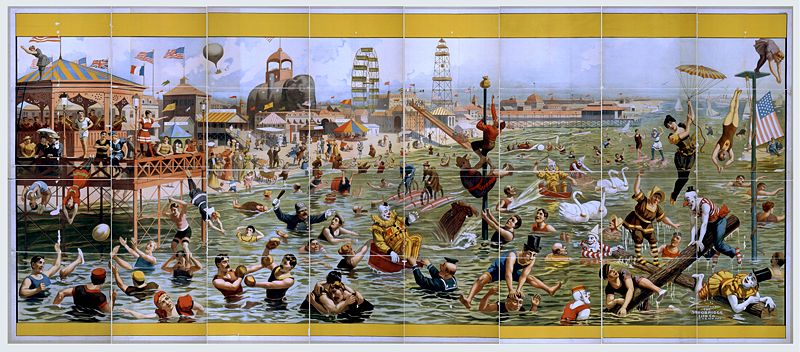
Coney Island, Brooklyn, NY
IN THIS ISSUE
LONDON Part Two
By John Mariani
NEW YORK CORNER
BÂTARD
By John Mariani
NOTES FROM THE WINE CELLAR
Prosecco
By Andrew Chalk
❖❖❖
LONDON, Part Two
By John Mariani
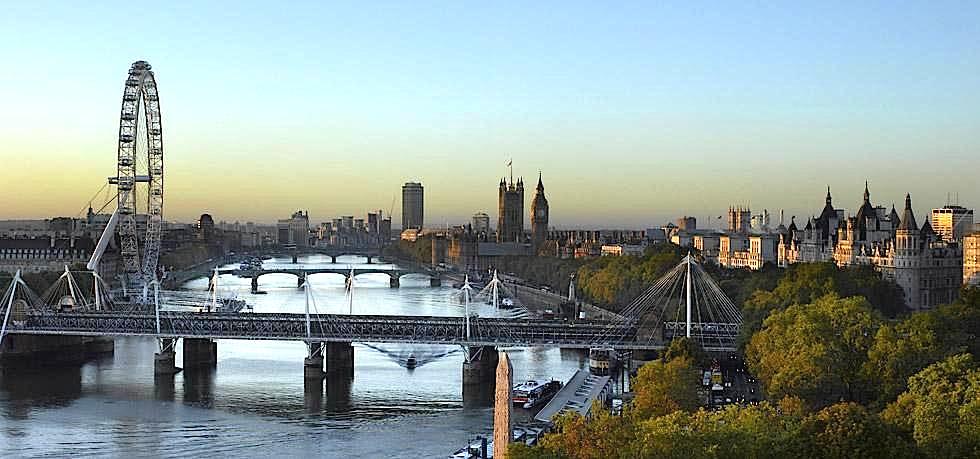
 Oscar
Wilde once cautioned that one should never
criticize society because only those who can’t get
into it do that. So it is with hotel dining
rooms, whose critics have probably not eaten in
one in the last twenty years and who are wholly
unaware that some of the finest restaurants in
every major city are in hotels.
Oscar
Wilde once cautioned that one should never
criticize society because only those who can’t get
into it do that. So it is with hotel dining
rooms, whose critics have probably not eaten in
one in the last twenty years and who are wholly
unaware that some of the finest restaurants in
every major city are in hotels.
I need only list
three or four to prove the point: Jean-Georges in New York,
Georges V in Paris, Anna Sacher in Vienna and De
Pisis in Venice. But London, more than any
other city, seems blessed with an exceptional number
of very fine restaurants located in very fine
hotels, including Helene Darroze at The Connaught,
Quilon at 51 Buckingham Gate, and Nobu at the
Metropolitan.
A recent visit to
London confirmed my contention after dining at the
restaurants in both the Mandarin-Oriental and the
Intercontinental hotels. Each has a restaurant
that is not only of the highest quality but also had
managed to win over both the very twee and usually
bitchy London food critics and hungry public that
translates to packed houses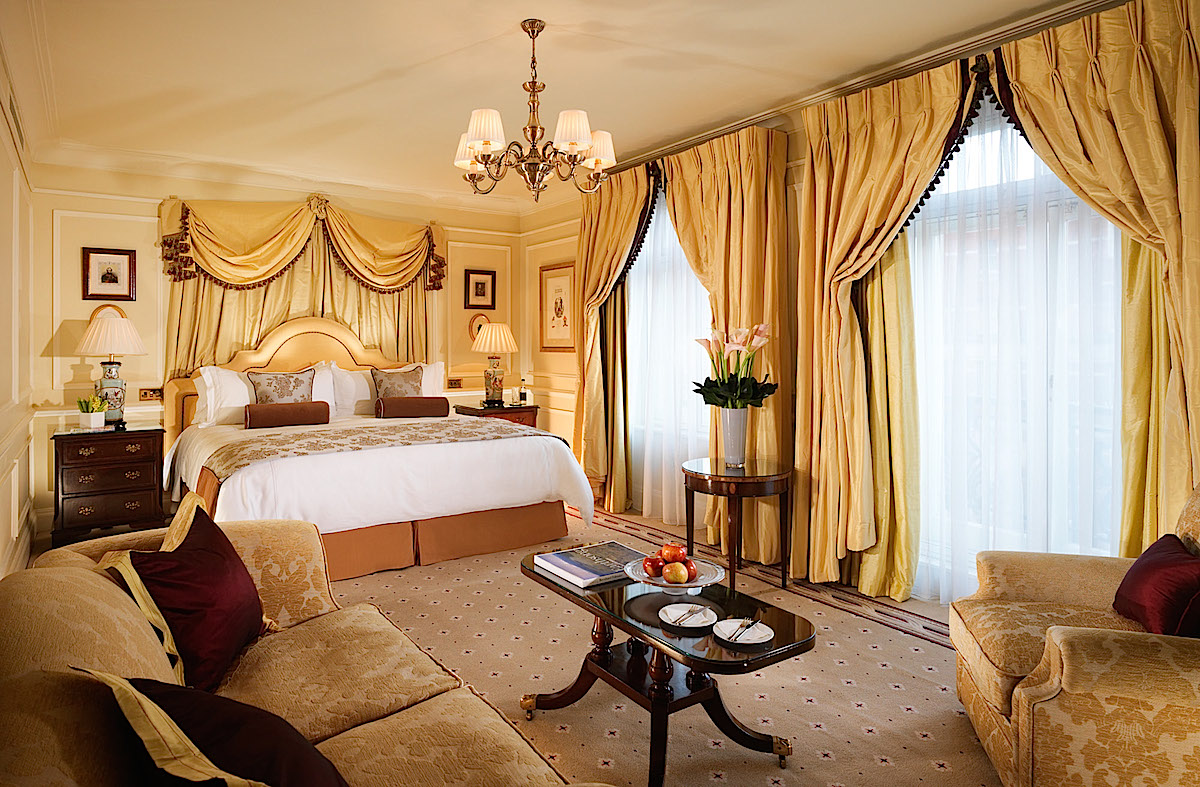 every
night.
every
night.
The Mandarin-Oriental
(right)
chain has clearly upped the ante for luxury in the
hotel industry, in the case of their London property
by taking over a fanciful Victorian building whose
169 rooms overlook Knightsbridge and which is very
convenient to the V&A Museum, Harrods, Harvey
Nichols and Green Park. The rooms are, in a
word, sumptuous. Every surface, chair, bedspread,
towel, and carpet is extra thick with luxurious
fabrics and the rooms, with miles of white marble,
are all very quiet within a city whose noise can
often try one’s nerves.
There are two
outstanding restaurants in the hotel, one Dinner by Heston
Blumenthal, which I reviewed last
year. The other is an offshoot of New York’s Bar Boulud,
only larger and more convivial. Instead of one
long room as in NYC, the London version begins with
a welcome at the commodious zinc-topped bar--they
make excellent cocktails--and open kitchen (below); then
there is a dining room and a counter where you may
feast on charcuterie.
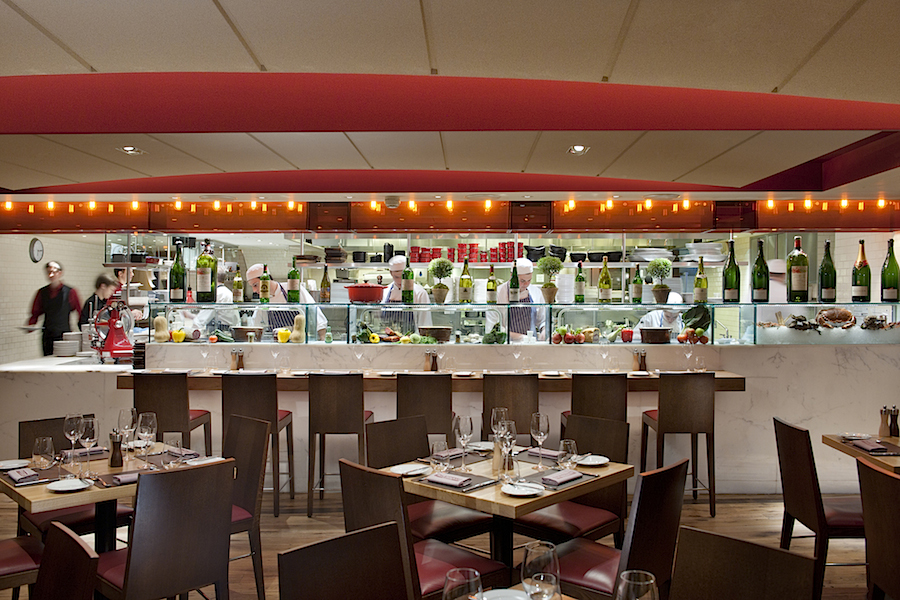 International
chef/restaurateur Daniel Boulud has brought in from
NYC Chef Dean Yasharian, who maintains a
well-established link to French charcuterie master
Sylvain Gasdon to produce the quality of artisanal
sausages, pâtés and terrines Boulud ate
while growing up in Lyon--fromage de
tête, joué de porc, compotée
de lapin, pâté grand-mère,
pâté de campagne aux foies de
volaille, saucisson cuit à l’ail,
pâté en croûte, saucissons
Lyonnais, and much more. You'll find none
better in London.
International
chef/restaurateur Daniel Boulud has brought in from
NYC Chef Dean Yasharian, who maintains a
well-established link to French charcuterie master
Sylvain Gasdon to produce the quality of artisanal
sausages, pâtés and terrines Boulud ate
while growing up in Lyon--fromage de
tête, joué de porc, compotée
de lapin, pâté grand-mère,
pâté de campagne aux foies de
volaille, saucisson cuit à l’ail,
pâté en croûte, saucissons
Lyonnais, and much more. You'll find none
better in London.
So, ordering a
charcuterie platter (₤16-32) is requisite here,
accompanied by a sturdy French regional wine from a
first-rate list.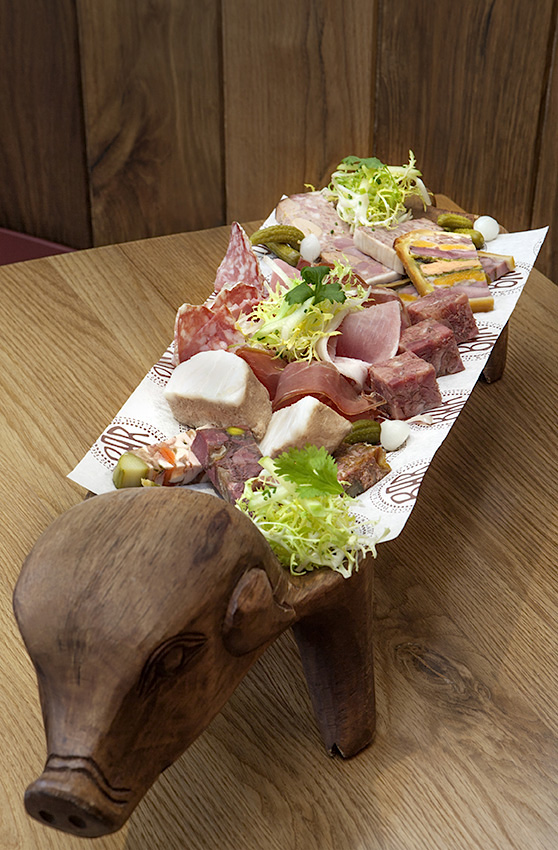 After
finishing off our selection of cured meats (right), my
guest and I ordered a fine sole limane (₤28), roasted on the bone, with a
rich brown butter sauce laced with lemon and
capers. Also, a rack of lamb with a kofta
meatball of ground lamb with rhubarb confit, Israeli
couscous and pomegranate jus (₤28);
accompanying these main courses were sweet minted
peas (₤4) and buttery pommes
lyonnaise (₤4).
After
finishing off our selection of cured meats (right), my
guest and I ordered a fine sole limane (₤28), roasted on the bone, with a
rich brown butter sauce laced with lemon and
capers. Also, a rack of lamb with a kofta
meatball of ground lamb with rhubarb confit, Israeli
couscous and pomegranate jus (₤28);
accompanying these main courses were sweet minted
peas (₤4) and buttery pommes
lyonnaise (₤4).
I am always weak
in the face of île
flottante (₤7), here steamed and served with
blood orange and Grand Marnier anglaise.
I
also enjoyed the rhubarb and green apple tart (₤8) with a ginger tuile and mascarpone-rhubarb
ice cream.
In keeping with
the hotel’s sumptuousness, the food at BB has its
own marvelous heft, characteristic of the best
French bourgeois cooking, which means no one leaves
hungry or unhappy.
Bar Boulud is open for
lunch and dinner daily;
the restaurant will be closed for vacation Aug.
18-31.
In
an entirely different style, no hotel in London has
a finer view of Hyde Park than the Intercontinental on
Park Lane, so book a room on that
side of the building (below). Unlike so many of its
established competitors, the “IC” has gone very
modern, very sleek, very, well, intercontinental.
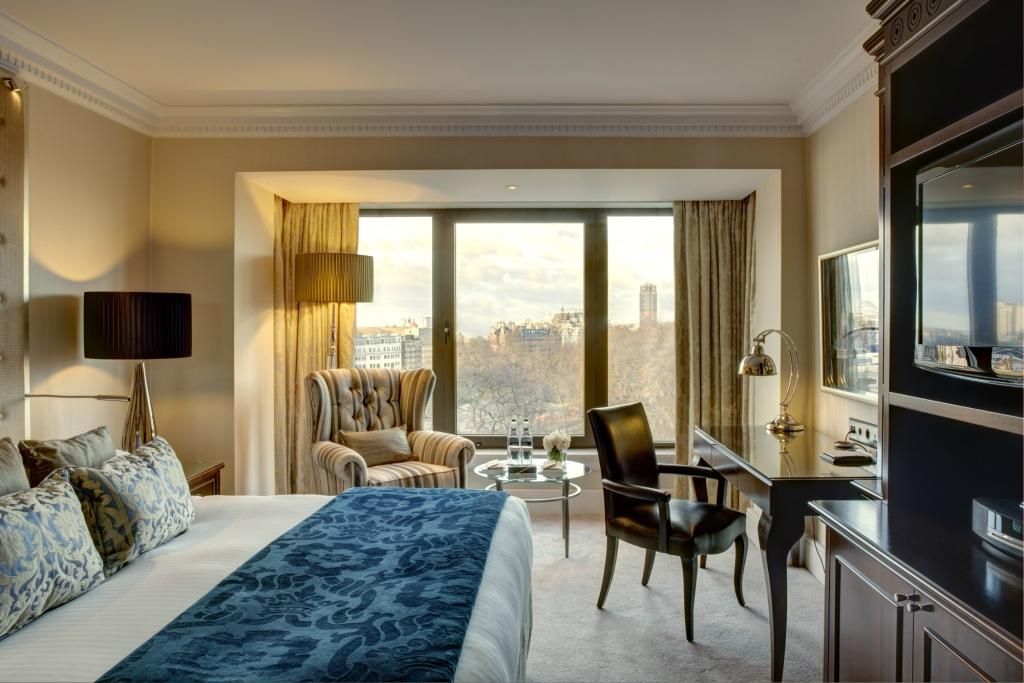 So, if the
lobby doesn’t reek Olde London, it impresses by
spaciousness and efficiency, from the opening of the
door to the amiable reception at the front desk and
concierge’s post. The commodious rooms are in
the same mode and, as much as possible, take full
advantage of London’s light.
So, if the
lobby doesn’t reek Olde London, it impresses by
spaciousness and efficiency, from the opening of the
door to the amiable reception at the front desk and
concierge’s post. The commodious rooms are in
the same mode and, as much as possible, take full
advantage of London’s light.
Off the lobby is
the handsome and equally modern Theo Randall dining
room (below),
whose name does not suggest that this is one of
London’s finest Italian restaurants (which London
hasn’t as many of as you might expect). The
eponymous chef has good breeding: he worked for
several years at the beloved River Café on
the Thames, then spent a year at Chez Panisse in
Berkeley, CA, both totems representing the very best
and the very simple. Randall plates his food
with a bit more lavish presentations, but
essentially he’s out after the flavors of the main
ingredients, whether in the unstintingly fresh
carpaccio of branzino (₤16)
with a touch of marjoram and chili or pan-fried
squid (₤14) with cannellini beans, a whiff
of anchovy, and chopped arugula.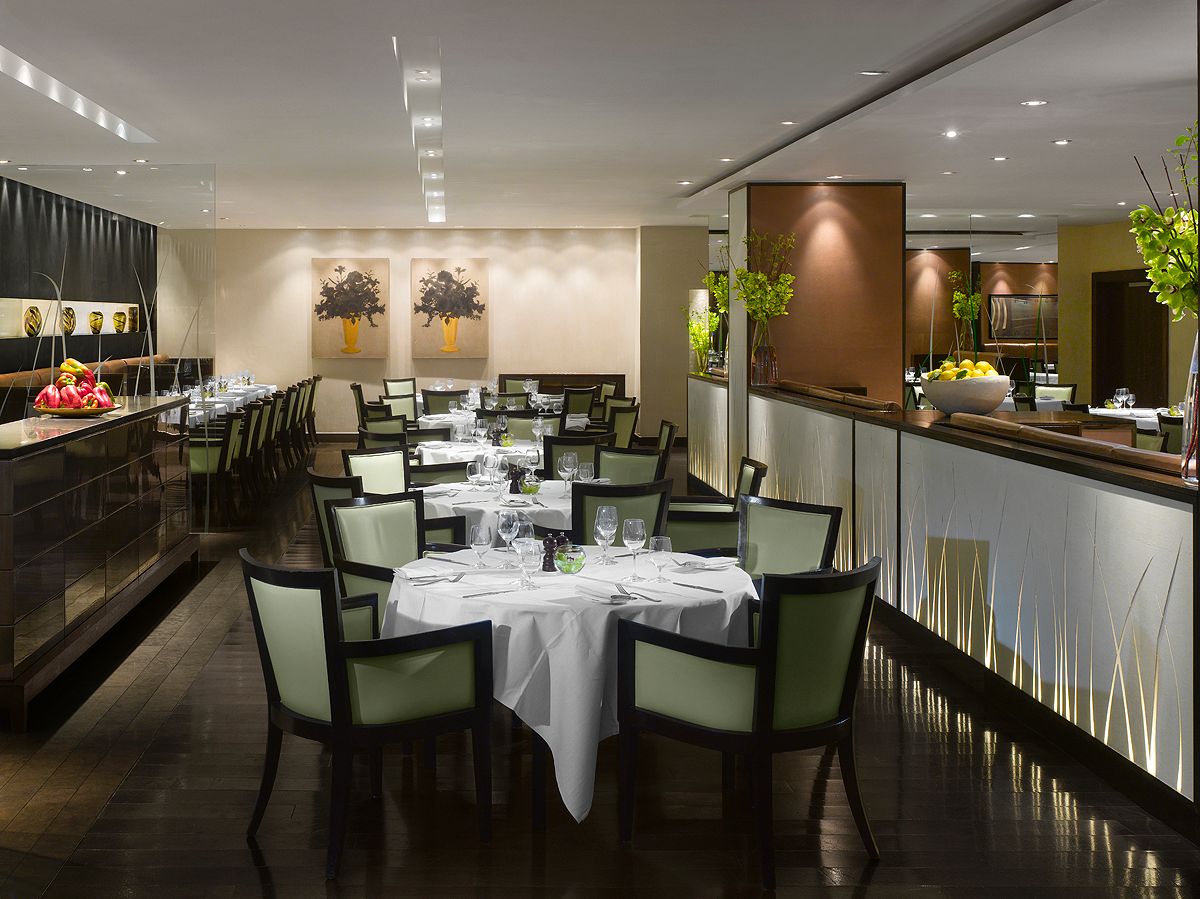
He fries zucchini
lightly and crisp, and his focaccia comes puffy and
warm to the table. Excellent pan-fried
scallops with lentils (₤19) carried too much freight from
anchovies, the Italian spring vegetable agretto,
capers and sage.
The pasta lessons
learned at the River Café have been applied
here to delicate ravioli stuffed with Swiss chard,
arugula, borage and ricotta glossed with butter and
sage (₤13/₤19;
half or full portion), and to simple fresh linguine
with Dorset blue lobster with violet artichokes (₤23/₤34). Cappelletti are
stuffed with slowly braised veal and pancetta for a
salty edge, served with mousserons
and porcini
(₤14/₤21).
Wood-roasting
lends wonderful but subtle flavor to meaty turbot
with roasted red peppers and Swiss chard simply
glazed with olive oil at the end (₤36). I found the squab on
bruschetta with peas, mint and pancetta (₤34) the epitome of good Italian
cooking, with nothing to disguise the deep flavors
of the ingredients. A bit disappointing—at
least to an American 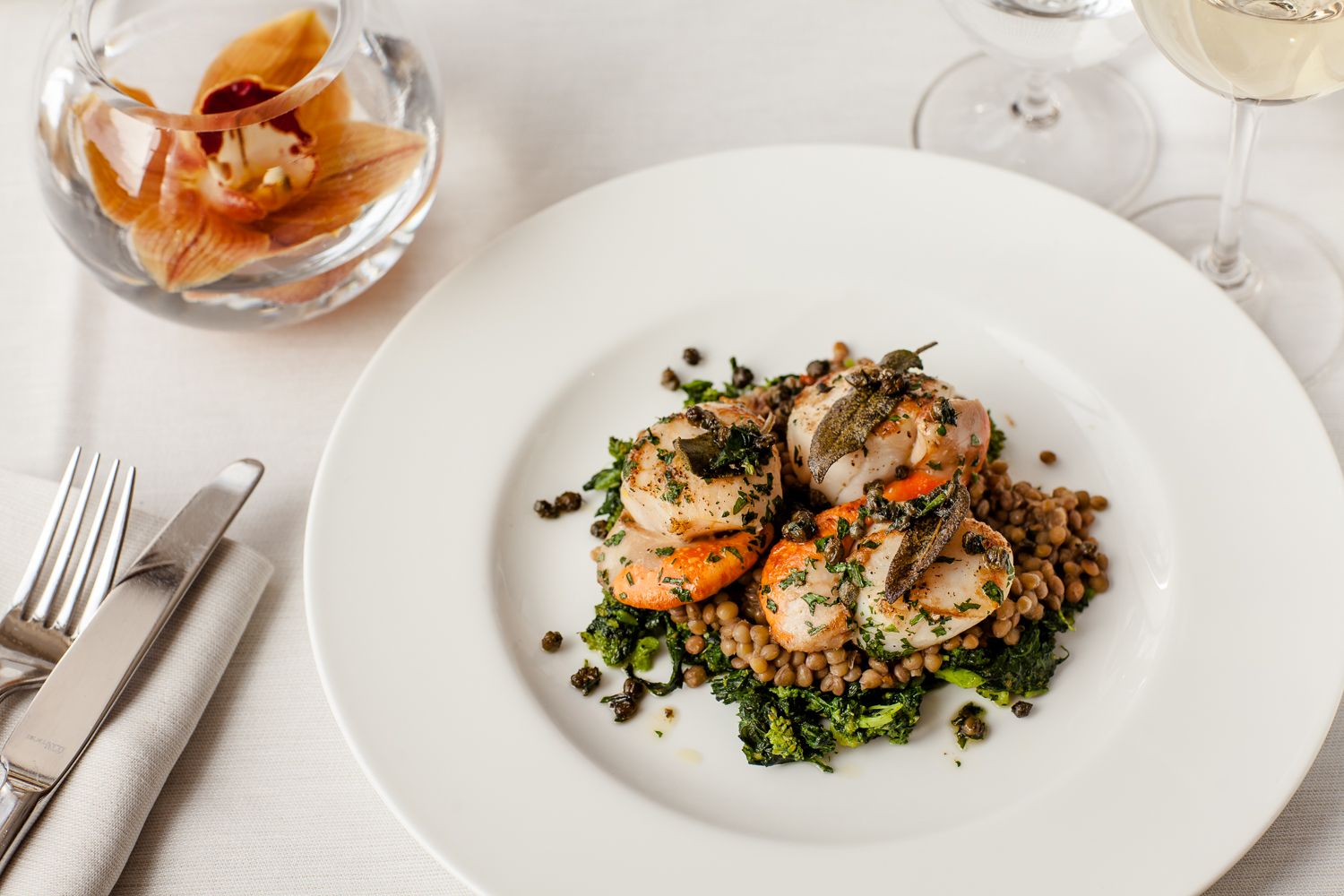 palate reared
on American beef--was a too lean Aberdeen beef
fillet with carrots, Jerusalem artichokes and fennel
(₤36).
palate reared
on American beef--was a too lean Aberdeen beef
fillet with carrots, Jerusalem artichokes and fennel
(₤36).
Desserts are as
admirably conceived, including a lemon tart made
with lemons from Amalfi (₤8); a warm almond tart with
strawberries and crème fraȋche (₤8); and fabulous chocolate and
roasted hazelnut ice cream (₤7)
that I wish they packaged and sold by the gallon.
Theo Randall shows
himself a gentleman chef with an Italian soul, and
his namesake restaurant is more civilized than most
new entries in London right now.
Monday -
Friday Lunch 12:00pm - 3:00pm; Dinner 6:00pm -
11:00pm; Saturday
Dinner 6:00pm -
11:00pm
Quickly
gentrifying East London has been getting a few
restaurants enticing enough to bring Central
Londoners out there, and one of the big draws is the
casual but very serious Clove Club in
the Shoreditch Town Hall. 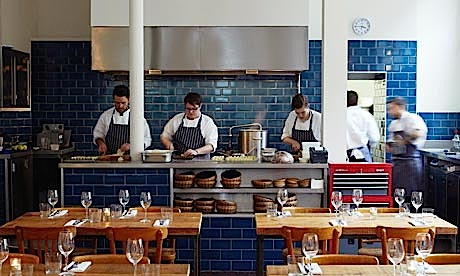 Seasonally
driven, chef-partner Isaac McHale, who began CC as a
pop-up eatery atop a parking garage, offers two
rooms and two options. In the restaurant and
kitchen (right)
you are served a tasting menu at ₤55 (with paired wines ₤40); mine was eleven small courses.
In the bar the menu is more à la carte.
The staff ranges from the extremely attractive and
affable to the dreary and overbearing.
Seasonally
driven, chef-partner Isaac McHale, who began CC as a
pop-up eatery atop a parking garage, offers two
rooms and two options. In the restaurant and
kitchen (right)
you are served a tasting menu at ₤55 (with paired wines ₤40); mine was eleven small courses.
In the bar the menu is more à la carte.
The staff ranges from the extremely attractive and
affable to the dreary and overbearing.
I found most of
what I was served exciting and delicious, and when
it wasn’t, it was the result of an eccentric streak,
as evidenced
by a combo of lamb with monk’s beard and wild
seaweed sauce, a marriage made not in heaven but on
a whim at the seashore.
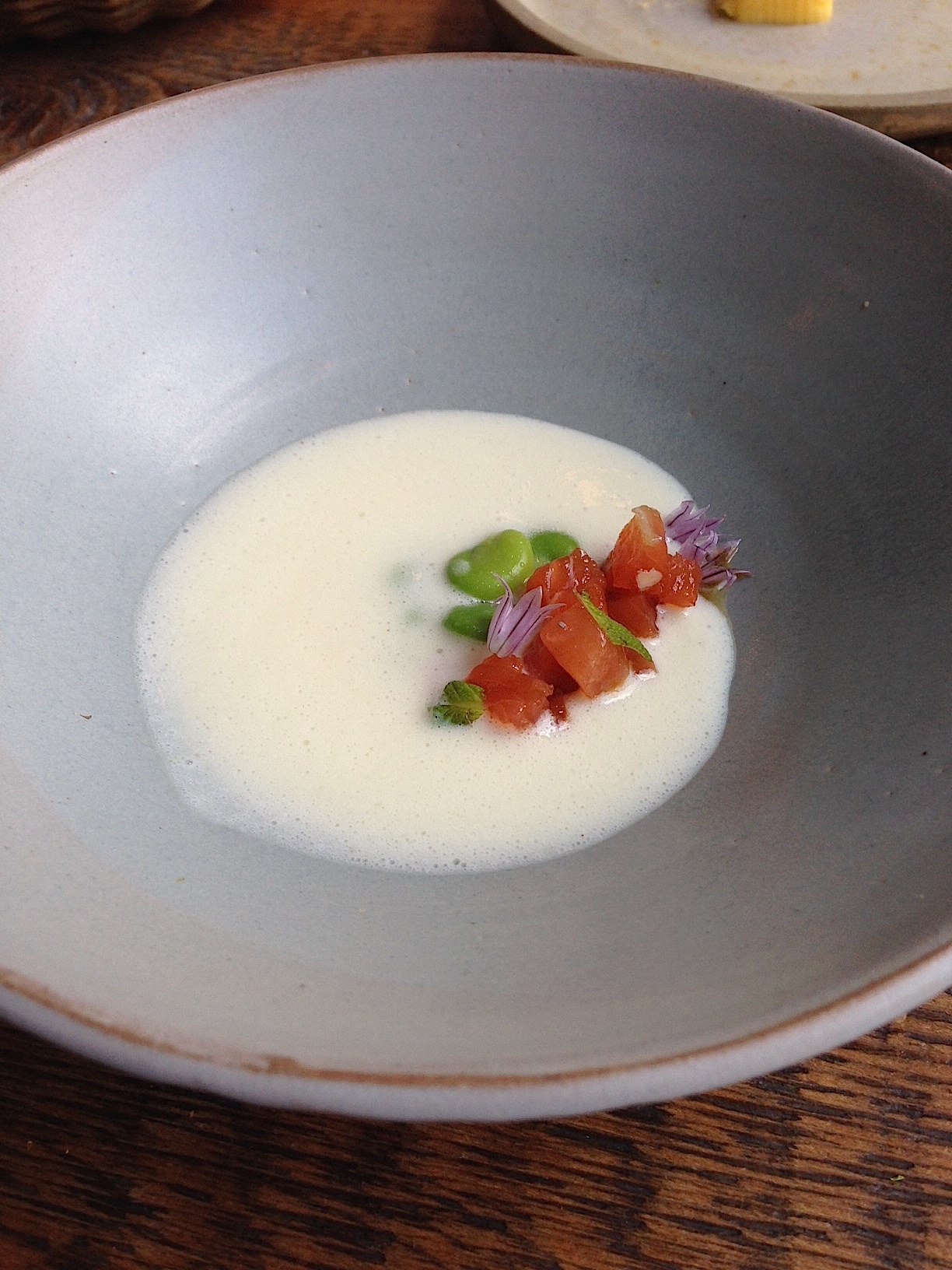 But that
oddity was a rarity in my meal.
Radishes with black sesame and kim chee-like gochuchang
was revelatory, and, while messy to eat in one gulp,
the “Black-headed Gull’s Egg” with buckwheat, celery
and lovage seemed sensuously decadent, and there was
much to like about Scottish blood pudding with
“overripe” pear puree, and a “flamed” sashimi of
mackerel with rhubarb, turnip and toasted oats for
texture. The only head-scratcher was a morsel
of buttermilk-fried chicken with pine salt that was
oddly not in the least (the way any home cook in
Alabama would make it).
But that
oddity was a rarity in my meal.
Radishes with black sesame and kim chee-like gochuchang
was revelatory, and, while messy to eat in one gulp,
the “Black-headed Gull’s Egg” with buckwheat, celery
and lovage seemed sensuously decadent, and there was
much to like about Scottish blood pudding with
“overripe” pear puree, and a “flamed” sashimi of
mackerel with rhubarb, turnip and toasted oats for
texture. The only head-scratcher was a morsel
of buttermilk-fried chicken with pine salt that was
oddly not in the least (the way any home cook in
Alabama would make it).
Dessert was
equally innovative, with black pepper ice cream and
Amalfi lemonade.
So, Clove Club is worth
the trip, mainly because its food is not the
kind you’ll find closer to the city’s center. And
the price is certainly right. McHale is not likely
to tone things down in his cooking, but I hope he
won’t go all modernist and molecular on us.
12 Noon - 2:30 pm.
I mentioned that London is not
rich in
first-rate Italian restaurants, although they keep
popping up like
daisies. And
most try in one way 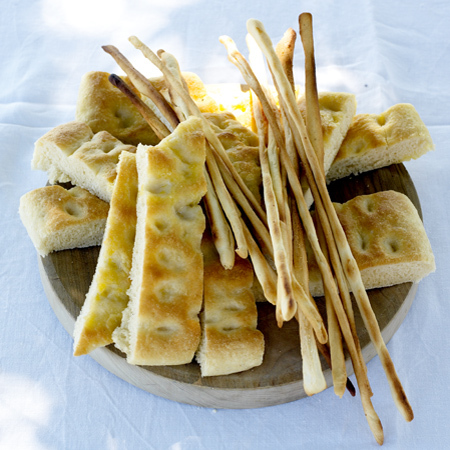 or another
to imitate the immensely successful River
Café on the Thames in
Hammersmith.
Opened by Ruth Rogers
and the late Rose
Gray in 1987 as
a kind of canteen for the staff in the design
building it occupies, The River
Café was immediately recognized as
something completely new in London—an
Italian restaurant that tried hard to be wholly
traditional via a cucina
rustica that aimed at simplicity
and flavor first and last.
or another
to imitate the immensely successful River
Café on the Thames in
Hammersmith.
Opened by Ruth Rogers
and the late Rose
Gray in 1987 as
a kind of canteen for the staff in the design
building it occupies, The River
Café was immediately recognized as
something completely new in London—an
Italian restaurant that tried hard to be wholly
traditional via a cucina
rustica that aimed at simplicity
and flavor first and last.
So popular is the Café that its guests are
overwhelmingly
devoted
regulars who all seem to
know each other.
Whenever I’ve be
fortunate enough to dine there, it’s been with one
of those regulars who attends
lunch every Sunday afternoon as if it were
mandatory Mass,
year round, and throughout those meals half
the people in the room are greeting the other
half. And
they all seem to know the
young, amiable staff, calling them by their first
names, trusting them as to
what’s special for the day.
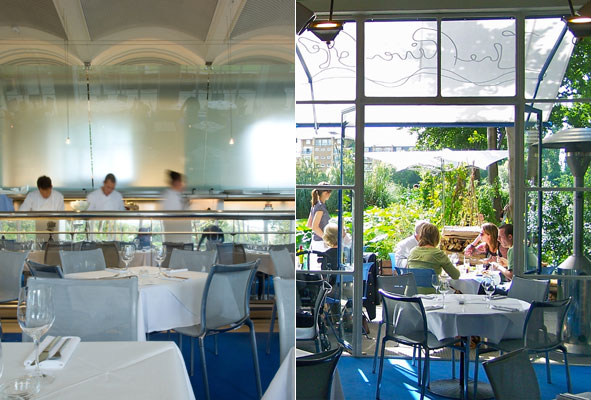 The food is, more or less, northern
in style,
with a lot of items from Liguria, without
neglecting southern regions when the
ingredients demand. The menu
changes pretty much daily and very much
seasonally, so that on my last trip in
June, there was Devon crab with
grilled, marinated and
raw tomatoes, with
a light aïoli
and purslane
(£20) and plump Scottish
langoustines seared with capers and wild oregano
and served with bright yellow
zucchini flowers. No one resists the breads.
The food is, more or less, northern
in style,
with a lot of items from Liguria, without
neglecting southern regions when the
ingredients demand. The menu
changes pretty much daily and very much
seasonally, so that on my last trip in
June, there was Devon crab with
grilled, marinated and
raw tomatoes, with
a light aïoli
and purslane
(£20) and plump Scottish
langoustines seared with capers and wild oregano
and served with bright yellow
zucchini flowers. No one resists the breads.
Pastas
are
all made in house, delicate and clearly produced
only in daily quantities,
which make the ravioli exceptionally light, with girolles,
creamy ricotta,
thyme, butter and parmigiano (£19), and tagliarini
with sweet small vongole
clams,
yellow tomatoes, a shot of dried chili and fresh
summer marjoram (£20).
Main
courses are just as simple, from turbot tranche
wood roasted with salted
anchovy, rosemary and red wine
vinegar, accompanied by fresh borlotti beans
(£39) to a whole wood-roasted Anjou
pigeon with girolles,
thyme and roast potatoes (₤37).
The
Café’s gelati and
sorbetti
(two for ₤8) are among the best
in London, very
close to the best I've had in Italy, and
the desserts (£10)
look like pictures in an English nursery rhyme,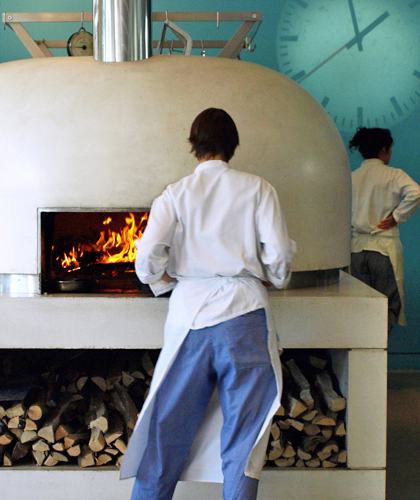 including an almond tart with
fresh strawberries or a fine English summer
pudding.
including an almond tart with
fresh strawberries or a fine English summer
pudding.
The
dining
room, despite a fire not too long ago, hasn’t
changed much in all these years,
still the long, bright convivial spot it’s always
been, still sort of
canteen-like, with a wide open kitchen and a
window wall overlooking a backyard
that at the moment is where everyone wants to sit. Children run on the grass,
dogs romp, and the river Thames
flows beyond.
It might be too
much to say The River Café is the best
restaurant in London, but in its
unassuming way and for its continued reliance on
the most cherished principles
of Italian cookery, it is surely the most
treasured.
The River Café is open for
lunch and dinner daily.
❖❖❖
By John Mariani
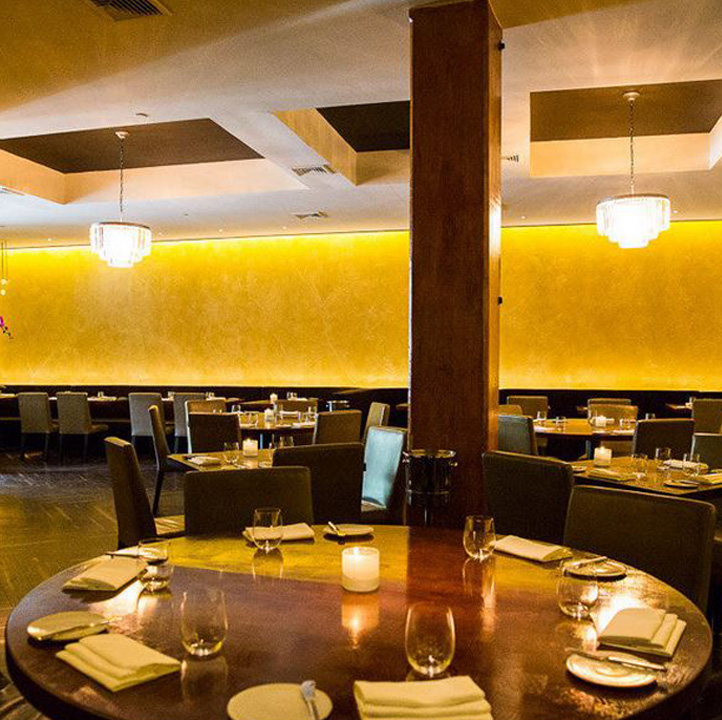
I might
as easily hail Nieporent for his charity work as
for his restaurants--raising
$1 million for the Windows of Hope Family Relief
Fund, benefit dinners for Citymeals-on-Wheels, and
much more that earned him the Humanitarian of the
Year Award in 2000 from the James Beard
Foundation. But in the world of gastronomy,
Nieporent--whom I’ll call Drew from here on--and
his Myriad Restaurant Group are counted as one of
the most innovative in the industry.
It all
began with a restaurant called Montrachet, which
opened three decades ago in
TriBeCa on an unlighted, cobblestone street
with more cracks than surface, back then a no
man’s land not so much because it was dangerous
but because it was nowhere. What Drew did
with 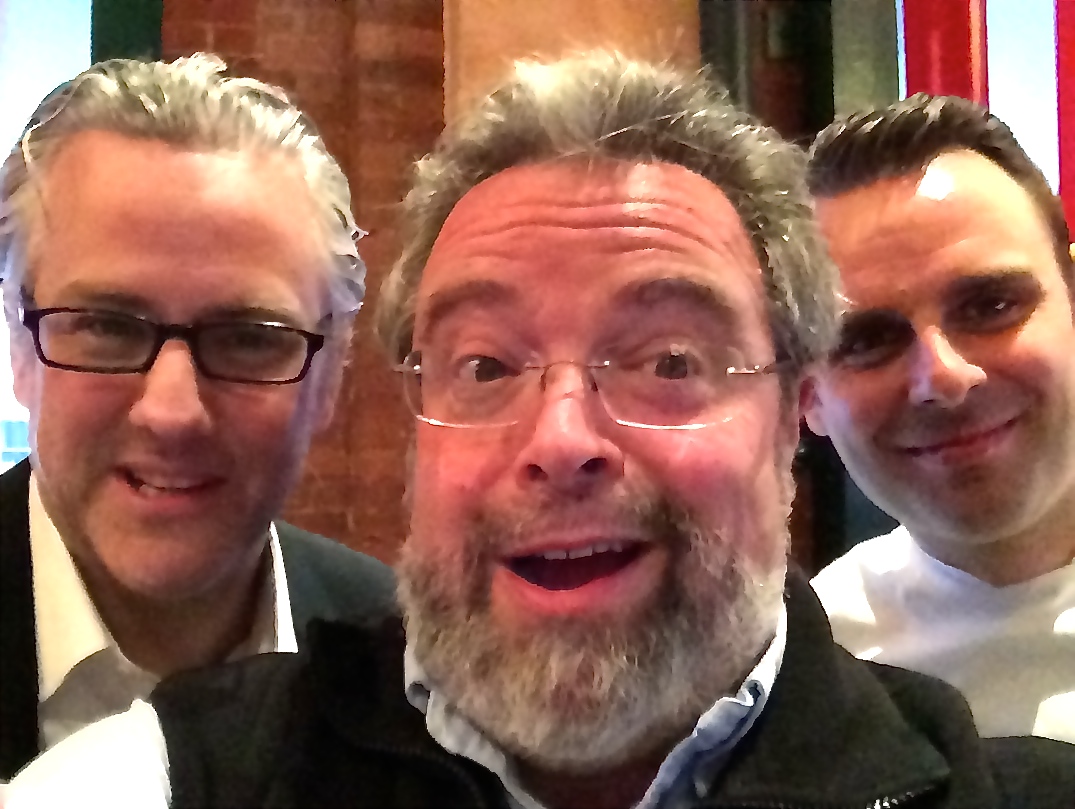 Montrachet, with a loan
from his mother and the talents of his first chef,
David Bouley, was to throw light on West Broadway
by opening up a moderately priced French
restaurant that won immediate media acclaim and
became one of the must-go places that influenced
so many to follow.
Montrachet, with a loan
from his mother and the talents of his first chef,
David Bouley, was to throw light on West Broadway
by opening up a moderately priced French
restaurant that won immediate media acclaim and
became one of the must-go places that influenced
so many to follow.
Myriad
went on to open the first Nobu, then more of them,
and its TriBeCa Grill is still counted among New
York’s most iconic restaurants. There were
some missteps along the way: overexpansion in
obscure locations like Telluride, and some catty
feuds with his chefs.
As
crowds waned at Montrachet, Drew re-invented it as
Corton, also much praised for chef Paul
Liebrandt’s highly creative cuisine, but too
cerebral for too many people. So Drew closed
it again, and, with partner John Winterman,
re-opened as Bâtard (all the restaurant’s
names have referred to Burgundy), with Austrian-born
Markus Glocker, formerly chef de cuisine at NYC’s
Gordon Ramsay at The London, as well as Charlie
Trotter’s in Chicago and Restaurant Steirereck in
Vienna. The crowds are again building. The
more things change the better they now are at
Batârd.
John Winterman, Drew Nieporent, Markus
Glocker
Not too much has been done to the premises,
although several tables--and all the
tablecloths--have been removed. The minimalist,
unadorned bas-relief walls have a golden shimmer
and the lighting is excellent. I’d only love to
have a small pot of highly colorful flowers on the
naked tables. And it is loud (that is under
current consideration).
What's also changed,
to everyone’s delight, are the prices, now a very
reasonable $55 for two
courses, $65 for three and $75 for four. (By
comparison with restaurants in Bâtard’s
league, the main courses alone at Gotham Bar &
Grill run $36-$52; at Gramercy Tavern the
three-course menu is $92; at Dovetail, four
courses run $88.) And while the wine list
has been whittled down a bit, it’s still
formidable and very well priced,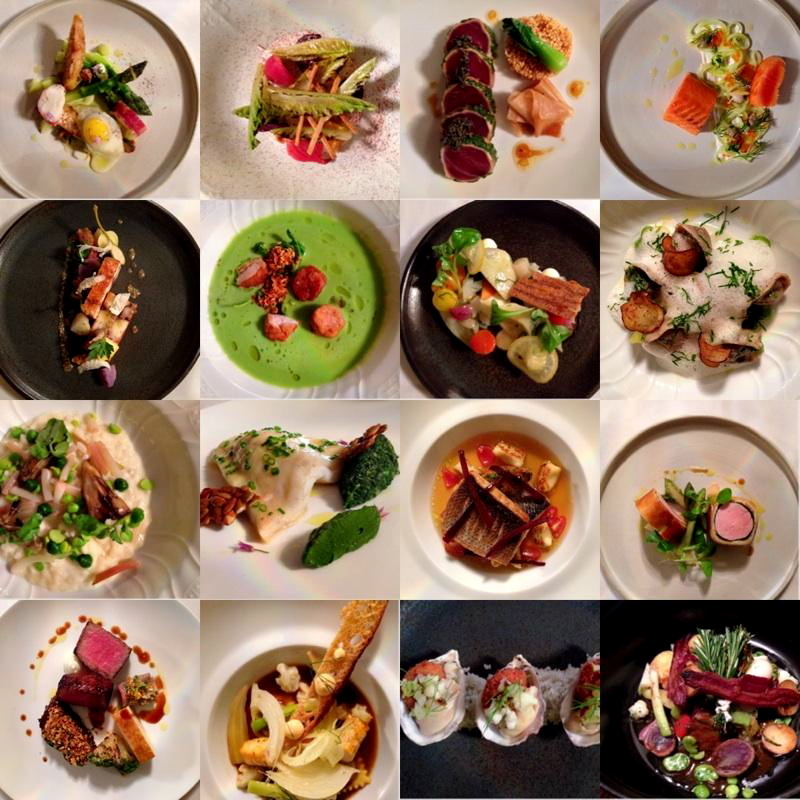 especially for some
Burgundies they’ve had a for a long while that you
won’t find easily at these prices.
especially for some
Burgundies they’ve had a for a long while that you
won’t find easily at these prices.
With my party
of four, I ranged over a menu of just the right
size--eight starters, seven main courses, plus a
couple of specials--from a lovely chilled pea soup
with unexpected and delicious slivers of fluke,
braised shallots and salsify crumble
to Octopus pastrami with braised ham hock, Pommery mustard
and new potatoes, which
shows off a bit of Glocker’s Austrian heritage.
Lobster was perfectly cooked, served with
green asparagus, zucchini blossom, and citrus
rind, while Parmesan-drenched risotto was properly
tender, perked up with pickled sunchokes, garbanzo
beans and lovage.
Apparently a big hit,
and for good reason, “rabbit flavors of
bouillabaisse” with saffron ravioli, turnips,
carrots and a sauce rouille is just novel enough
to applaud and classic enough to acknowledge.
Viennese tradition comes into charming play
with Glocker’s crisp and buttery baby chicken
schnitzel with potato salad, the tubers cooked in
lovage-infused veal stock.
Lamb for two is indeed
generous enough for a couple ($15 supplement),
plated as a generous roasted rack, shoulder
confit, crispy lamb bacon, fava beans and tangy
lemon, arriving in a Creuset ramekin.
For your third course
you must decide between a superb selection of
perfectly ripe cheeses or four desserts, all of
them very good, from Key lime pie with a buckwheat
crust, cilantro and herbal ice cream to a
caramelized milk bread with fennel yogurt,
strawberries and brown butter ice cream. The
banality of all those dense Black Forest cakes of
the past is here redeemed with a rich, moist
chocolate sablée, kirsch chantilly, Bing
cherries.
If the
restaurant at 239 West Broadway needed redemption,
Drew Nieporent certainly hasn’t. He remains
not just vital to New York’s restaurant scene but
at this point has achieved the station of an elder
who still has much to tell those flailing about in
mere novelty about the true excellence in
maturity.
Bâtard is
open Tuesday
through Saturday.
❖❖❖
NOTES FROM THE WINE CELLAR
PROSECCO--The Pursuit of More Individualistic Wines
By
Andrew Chalk
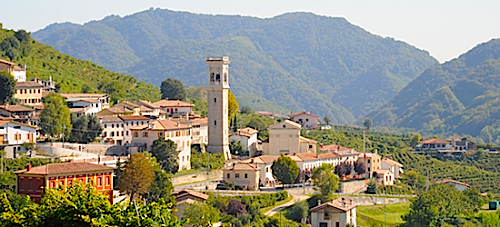
Twenty years ago the entire
sales of Prosecco, the Italian sparkling wine, in
the United States market amounted to less than 500
cases a year. Last year sales exceeded two million
cases and that was up 27% from the previous year.
This is a category that we love, but why? What is it
that makes Prosecco so popular?
I tried to throw some light on
that recently when Prosecco producer Mionetto sent me
samples of five of their wines, from simple and
inexpensive to pricier examples near the top of
their line. It is fitting that Mionetto should do
this as they were the producer that first shipped
Prosecco in volume to the USA (in 2000).
For most of its existence here,
Prosecco has been popular for two things: its
competitive price versus the best known sparkling
wine, Champagne (from the homonymous region in
France), and as a mixer to make the Bellini cocktail.
While giving the wine publicity, neither role
promoted the wine as a first-class style of
sparkling wine in its own right.
Prosecco has also changed over
time, making it harder to pin down hallmarks as
easily as one can do for Champagne. United States
troops marching up Italy during the second world war
and postwar travelers in the area prior to 1960
would have found Prosecco to be a sweet wine (like
modern day Asti Spumante from Piedmont). How it came
to take on the modern-day dry character is somewhat
hard to fathom, but better production techniques are
considered an important part of the transition.
In the process, Prosecco began to
spring up from areas of Italy outside the original
production area of Veneto and Friuli Venezia Giulia.
In fact, some of it came from outside Italy. The
original producers decided to protect the Prosecco
name as a designated production area and to phase
out the use of the word to describe the predominant
grape used to make the wine. That became
standardized as Glera and the
classical production areas obtained DOCG status with
tighter yield standards. There was a renewed focus
on quality. The range of wines that Mionetto
produces is a product of that, and the fact that
they sent out the range to the media indicative of
their desire to publicize that fact.
I gathered five private
collectors, all of a skeptical cast of mind, at Momo’s Italian Kitchen (a
good Italian restaurant that is also BYOB), to taste
through the Mionetto wines on their own and
accompanying a variety of food. We tasted the wines
in order of (what I thought would be) increasing
quality.
“Il” Prosecco, DOC Prosecco
Two
points up front: First, Prosecco is usually not made
the same way as Champagne. The latter becomes
sparkling through a second fermentation in the
bottle in which the final wine is sold (the
so-called méthode traditionelle). Prosecco
can legally be made this way but most of it is made
in a tank using the Charmat process. It undergoes a
secondary fermentation in the tank and is then
injected into bottles. This is a less expensive
production technique.
Second, almost all Prosecco is
not vintage-dated. This allows producers to blend
wine from multiple years to make the final product,
helping to maintain a ‘house style’. Vintage wine (a
millesimato) is legal and will, I predict, become
more common in the next few years as Prosecco
producers strive to distinguish themselves from a
host of lookalike sparkling wines.
We started at the budget end of
the range with “Il” Prosecco, DOC Prosecco ($11),
Mionetto’s budget offering. This actually comes with
a crown cap which, far from being a marketer’s
abomination, is the traditional closure in Italy. It
is a simple, low-alcohol (10.5%), slightly sweet (it
is too sweet to be labelled ‘Brut’, for dry, in
Europe), fruity and spritzy wine made from Glera. It
is ideal for poolside drinking or with food such as
dessert tarts or fruit.
Prosecco,
Brut,
DOC Treviso
Next
the Prosecco, Brut, DOC Treviso ($12) was a step up
the quality ladder into Mionetto’s mid-range
collection. Yellow straw in color. It is dry, but
not bone dry (the sugar is 12g/litre, on the
boundary between brut and ‘extra dry’) and made from
100% Glera grapes. The pleasant palate has hints of
golden apples and peach and a lively acidity. This
can be quaffed or served with salad, gnocchi in
cheese sauce, or with fruity pastries and desserts.
Prosecco,
Organic,
DOC Treviso
A sideways step to the Prosecco,
Organic, DOC Treviso ($16) which is made from
organically grown grapes and vinified with 18g/litre
of sugar, enough to push it out of brut and extra
dry status and into the ‘dry’ category. Yellow
color. Lime flavor from the fruit. More yeasty
flavor, and heavier mouthfeel. Less sweet to the
tongue than the residual sugar level would lead you
to believe.
Cuvée
Luxury
Valdobbiadene Superiore, DOCG Valdobbiadene Extra
Dry
The Cuvée Luxury Valdobbiadene
Superiore, DOCG Valdobbiadene Extra Dry ($19) was
the first example from Mionetto’s top-end line and
the first example from the DOCG area for Prosecco.
The terrain in Valdobbiadene is characterised by
steep hillsides that have to be hand-harvested and
which is owned by hundreds of small growers with
average plots of between 2.5 and 10 acres.
This wine is crisper than its
predecessors. It has more mineral components to the
flavors. It is complex and less defined by primary
fruit flavors. The color is straw. This is the first
wine that I would serve someone who wanted evidence
of Prosecco’s quest for quality. A very refined
example.
Cuvée
Luxury
Cartizze, DOCG
The Cuvée Luxury Cartizze,
DOCG ($35) is from the closest thing to a Grand Cru
in Prosecco, the Cartizze vineyard is 260 acres on a
steep hillside. The vineyard land here apparently
sells for over a million euros per hectare (2.5
acres).
This wine is similar in character
to the last in eschewing forward fruit for a more
complex balance of mineral and fruit. The color is
yellow straw. The nose is very faint, it is very
much a palate wine.
As with Champagne, I found the
range of food that Prosecco, particularly the last
two, could be successfully paired with was very
broad. We tasted them throughout the meal and, with
the exception of heavy red meats, which overwhelmed
them, they were an impressive match.
Add me to the list of those who
are persuaded of the Prosecco region’s improvements.
I look forward to seeing how far non-vintage,
Charmat method wines can go. The levels achieved
thus far easily exceed what I would have expected.
Mionetto wines are available in
the Dallas area at HEB, Kroger, Central Market,
Whole Foods, Total Wine & More, Spec’s Liquor,
United Market Street, Trader Joe’s and Target (only
IL Prosecco).
❖❖❖
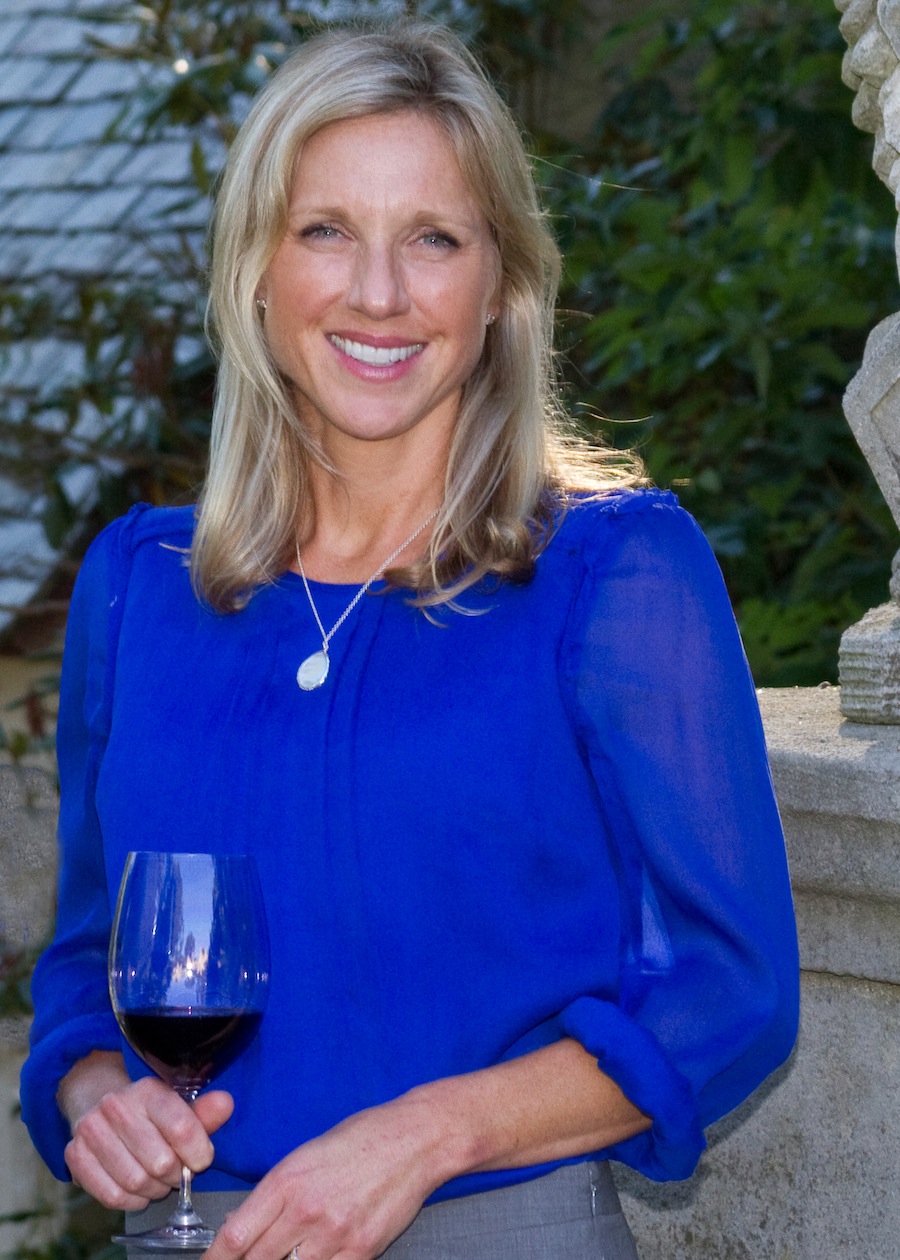
New Moon on the
Rise
by Cristina Mariani-May
co-CEO
of Banfi Vintners
America's
leading wine importer
Mauro Merz is a
man on a mission.
As head winemaker for Fontana Candida, the leading
name in wines from Italy’s Frascati region, Merz is
the driving force behind a movement dedicated to
ushering in a return to the high-quality,
small-production  wines of the region’s past.
wines of the region’s past.
Those “heritage wines” reflect millennia of winemaking
experience and beloved by multiple generations of
Romans. They were the reason Lazio’s Frascati
region was among the first to receive the DOC
recognition in the mid-1960s – it is a classic.
However, worldwide demand for Frascati in the 1970s
was followed by a period of over-production and an
overall decline in quality, leading to a gradual loss
of respect over the next couple of decades.
At the dawn of the 21st
century, the latest generation of growers in the area
faced the likelihood that their land was more valuable
to real estate developers tugging at the urban sprawl
of Rome than it was for grape growing.
Merz,
born and educated in northern Italy but having spent
most of his professional career in Frascati, was
determined to turn that around. In 2005 he
enacted a plan designed to bring Frascati back to its
historic glory and rightful destiny, and today is
reaping – and sipping – the results. Mauro’s
mission is twofold: start from the ground up to give
growers an incentive to restore quality and typicity
in their fruit, and then use that quality to combat
standardization and create a wine that evokes
the area’s greatest winemaking traditions in a
contemporary voice.
First the fruit: Merz gave incentives to the farmers
who would bring him quality fruit, and worked with him
to gradually replant their vineyards using old clones
of Malvasia di Lazio and others that offer more
quality than quantity. He instituted a bonus program
based on the health of the fruit conferred to the
winery, offers the growers the daily technical support
of a professional vineyard manager hired by Fontana
Candida, and supports the base market price of grapes
in the area – sometimes exceeding it by as much as
40%. Urban developers could offer cash too, but
Mauro offered something better – a future filled with
pride, sustainability and an improved quality of life
– not to mention better wine!
With good fruit in the winery,
Merz began to orchestrate his masterpiece.
Rather than one single fermentation, he combines
three: that typical of ‘modern’ white wines with clean
must fermented at controlled temperatures;
fermentation of ripe - and in some cases slightly
dried – fruit in contact with the skins of crushed
grapes; and, last but not least, whole berry
fermentation of perfectly healthy grapes, de-stemmed
by hand and floating in the must of grapes from the
same vineyard picked days earlier.
Each of those wines could not tell the complete story
on its own; it is the blend of these three techniques
that yields Luna Mater, a wine or remarkable
character. To take it one step further, after bottling
the wine is aged in a traditional cellar beneath the
winery, hand carved from the tufaceous rock
generations ago, naturally cool and humid. Talk
about a wine with a sense of place!
Luna Mater has an intense bouquet of exotic fruit
aromas, honeysuckle, and acacia flowers. It is
full flavored and savory, with a lingering finish
reminiscent of ripe pear and almonds. It is a
great pairing to a wide range of foods, from simple
pasta dishes to the roast lamb that is so typical of
the Roman countryside.
The label of Luna Mater was designed by Roman Artist
Domenico Bianchi; it depicts the reflection of the
moon in the waters of the fontana
candida or generous fountain that springs from
the middle of the vineyards. The moon and its
influence on agricultural cycles has always played a
role in grape growing and winemaking; that role is as
poignant today as it was centuries ago. So too is a
delicious wine!
NOT TO MENTION THOSE GUYS IN THE WHITE SHEETS AND HOODS

Shiloh Brew & Chew, a "family-style" steakhouse in Tennessee, posted a sign in its window declaring "Guns Are Welcome. " Owner Sharma Floyd contends, "I lost a whole group of motorcyclists because they thought I didn't allow weapons."
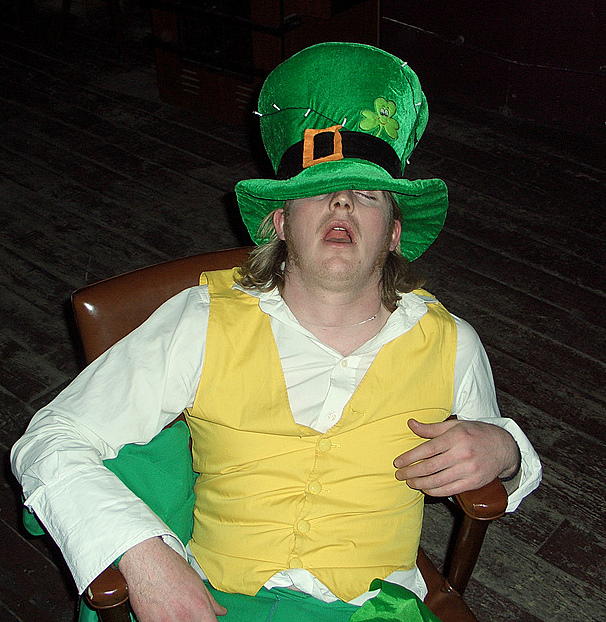 AND IT'S ABOUT TIME!
AND IT'S ABOUT TIME!
Peter's Place Cafe restaurant in Waterville,
Ireland,
has banned "loud' Americans."
Any of John Mariani's
books below may be ordered from amazon.com.
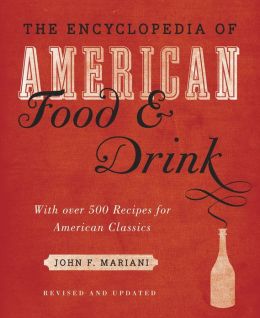 |
The Encyclopedia of American Food and Drink by John F. Mariani (Bloomsbury USA, $35) Modesty forbids me to praise my own new book, but let me proudly say that it is an extensive revision of the 4th edition that appeared more than a decade ago, before locavores, molecular cuisine, modernist cuisine, the Food Network and so much more, now included. Word origins have been completely updated, as have per capita consumption and production stats. Most important, for the first time since publication in the 1980s, the book includes more than 100 biographies of Americans who have changed the way we cook, eat and drink -- from Fannie Farmer and Julia Child to Robert Mondavi and Thomas Keller. "This book is amazing! It has entries for everything from `abalone' to `zwieback,' plus more than 500 recipes for classic American dishes and drinks."--Devra First, The Boston Globe. "Much needed in any kitchen library."--Bon Appetit. |
"Eating Italian will never be the same after reading John Mariani's entertaining and savory gastronomical history of the cuisine of Italy and how it won over appetites worldwide. . . . This book is such a tasteful narrative that it will literally make you hungry for Italian food and arouse your appetite for gastronomical history."--Don Oldenburg, USA Today. "Italian
restaurants--some good, some glitzy--far
outnumber their French rivals. Many of
these establishments are zestfully described
in How Italian Food Conquered the World, an
entertaining and fact-filled chronicle by
food-and-wine correspondent John F.
Mariani."--Aram Bakshian Jr., Wall Street
Journal.
"Equal parts
history, sociology, gastronomy, and just
plain fun, How Italian Food Conquered the
World tells the captivating and delicious
story of the (let's face it) everybody's
favorite cuisine with clarity, verve and
more than one surprise."--Colman Andrews,
editorial director of The Daily
Meal.com. "A fantastic and fascinating
read, covering everything from the influence
of Venice's spice trade to the impact of
Italian immigrants in America and the
evolution of alta cucina. This book will
serve as a terrific resource to anyone
interested in the real story of Italian
food."--Mary Ann Esposito, host of PBS-TV's
Ciao
Italia. "John Mariani has written the
definitive history of how Italians won their
way into our hearts, minds, and
stomachs. It's a story of pleasure over
pomp and taste over technique."--Danny Meyer,
owner of NYC restaurants Union Square
Cafe, The Modern, and Maialino.
|
 |
 |
 |
 |
 |
 |
 |
 |
 Everett Potter's Travel Report:
Everett Potter's Travel Report: 
 Eating Las Vegas
is the new on-line site for Virtual Gourmet
contributor John A. Curtas., who since 1995
has been commenting on the Las Vegas food
scene and reviewing restaurants for Nevada
Public Radio. He is also the
restaurant critic for KLAS TV, Channel 8 in
Las Vegas, and his past reviews can be
accessed at KNPR.org.
Click on the logo below to go directly to
his site.
Eating Las Vegas
is the new on-line site for Virtual Gourmet
contributor John A. Curtas., who since 1995
has been commenting on the Las Vegas food
scene and reviewing restaurants for Nevada
Public Radio. He is also the
restaurant critic for KLAS TV, Channel 8 in
Las Vegas, and his past reviews can be
accessed at KNPR.org.
Click on the logo below to go directly to
his site.

Tennis Resorts Online: A Critical Guide to the World's Best Tennis Resorts and Tennis Camps, published by ROGER COX, who has spent more than two decades writing about tennis travel, including a 17-year stretch for Tennis magazine. He has also written for Arthur Frommer's Budget Travel, New York Magazine, Travel & Leisure, Esquire, Money, USTA Magazine, Men's Journal, and The Robb Report. He has authored two books-The World's Best Tennis Vacations (Stephen Greene Press/Viking Penguin, 1990) and The Best Places to Stay in the Rockies (Houghton Mifflin, 1992 & 1994), and the Melbourne (Australia) chapter to the Wall Street Journal Business Guide to Cities of the Pacific Rim (Fodor's Travel Guides, 1991).


MARIANI'S VIRTUAL GOURMET
NEWSLETTER is published weekly. Editor/Publisher: John
Mariani.
Editor: Walter Bagley. Contributing Writers: Christopher Mariani,
Robert Mariani, John A.
Curtas, Edward Brivio, Mort Hochstein, Andrew Chalk,
and Brian Freedman. Contributing
Photographers: Galina Stepanoff-Dargery,
Bobby Pirillo. Technical Advisor: Gerry McLoughlin.
To un-subscribe from this newsletter,click here.
© copyright John Mariani 2014
